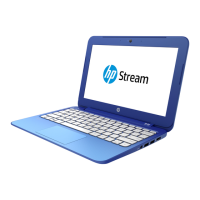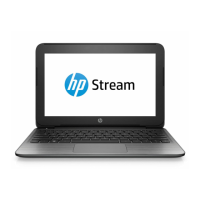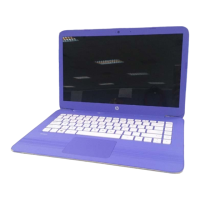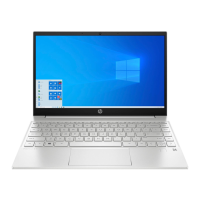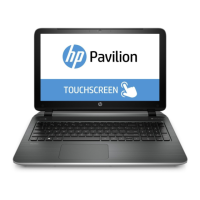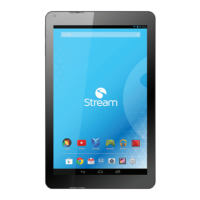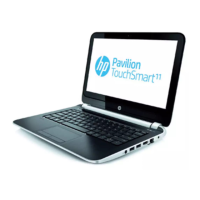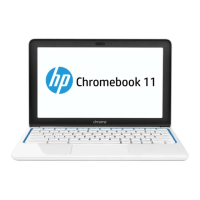Do you have a question about the HP Stream 11 Pro and is the answer not in the manual?
| Form factor | Clamshell |
|---|---|
| Product type | Laptop |
| Product color | Black, Grey |
| Country of origin | China |
| Stepping | C0 |
| Tjunction | 100 °C |
| Processor cache | 1 MB |
| Processor cores | 2 |
| System bus rate | - GT/s |
| Processor family | Intel® Celeron® |
| Processor series | Intel Celeron Processor N2000 Series for Mobile |
| Processor socket | BGA 1170 |
| Processor codename | Bay Trail |
| Processor frequency | 2.16 GHz |
| Processor cache type | L2 |
| Processor lithography | 22 nm |
| Processor manufacturer | Intel |
| Processor front side bus | - MHz |
| PCI Express slots version | 2.0 |
| Processor boost frequency | 2.58 GHz |
| Processor operating modes | 32-bit, 64-bit |
| ECC supported by processor | No |
| PCI Express configurations | 1x4 |
| Thermal Design Power (TDP) | 7.5 W |
| Scenario Design Power (SDP) | 4.5 W |
| Maximum number of PCI Express lanes | 4 |
| Motherboard chipset | - |
| Internal memory | 2 GB |
| Memory clock speed | 1333 MHz |
| Memory form factor | On-board |
| Internal memory type | DDR3L-SDRAM |
| SSD capacity | The Solid State Drive's storage capacity in Gigabytes. |
| Storage media | SSD |
| Card reader integrated | Yes |
| Total storage capacity | 32 GB |
| Compatible memory cards | SD, SDHC, SDXC |
| Number of SSDs installed | 1 |
| Display surface | Matt |
| Display diagonal | 11.6 \ |
| Display resolution | 1366 x 768 pixels |
| Native aspect ratio | 16:9 |
| Discrete graphics card model | Not available |
| On-board graphics card model | Intel® HD Graphics |
| On-board graphics card base frequency | 311 MHz |
| On-board graphics card burst frequency | 792 MHz |
| Audio system | DTS Studio Sound |
| Wi-Fi standards | 802.11b, 802.11g, Wi-Fi 4 (802.11n) |
| Bluetooth version | 4.0 |
| Top Wi-Fi standard | Wi-Fi 4 (802.11n) |
| Charging port type | DC-in jack |
| USB 2.0 ports quantity | USB 2.0 ports have a data transmission speed of 480 Mbps, and are backwards compatible with USB 1.1 ports. You can connect all kinds of peripheral devices to them. |
| VGA (D-Sub) ports quantity | 0 |
| Pointing device | Touchpad |
| Operating system installed | Windows 8.1 |
| Operating system architecture | 64-bit |
| Processor code | SR1YJ |
| Processor ARK ID | 82103 |
| Processor package size | 25 x 27 mm |
| Intel Smart Connect Technology version | 1.00 |
| Battery capacity | 37 Wh |
| Battery life (max) | - h |
| Number of battery cells | 3 |
| AC adapter power | 45 W |
| Sustainability certificates | EPEAT Silver, ENERGY STAR |
| Depth | 205.7 mm |
|---|---|
| Width | 300 mm |
| Height | 19.7 mm |
| Weight | 1280 g |
Guidance on locating essential hardware and software information on your computer.
Identifies and describes the computer's display components, including webcam and microphones.
Details the function and operation of the computer's power button and its various states.
Explains the function of special keys like Esc, Fn, and Windows key, along with action keys.
Describes the various indicator lights on the computer, such as power, Caps Lock, and mute lights.
Details the touchpad zone and its buttons, explaining how to use finger gestures for navigation.
Identifies components on the left side: security cable slot, power connector, AC adapter light, SIM slot, memory card reader.
Identifies components on the right side: power light, audio/mic jack, USB ports, and HDMI port.
Identifies components on the bottom: primarily the speakers.
Explains how to find product name, serial number, model number, and warranty information on the computer.
Provides an exploded view of major internal components and their spare part numbers.
Details individual parts of the display assembly and their corresponding spare part numbers.
Lists various miscellaneous parts and accessories with their spare part numbers.
Lists the essential tools needed to perform hardware removal and replacement procedures.
Provides important guidelines and precautions for safe and effective disassembly and assembly procedures.
Offers guidance on handling plastic components carefully to prevent damage during disassembly and reassembly.
Provides crucial advice on handling, routing, and preventing damage to internal cables and connectors.
Details precautions for safely handling fragile drive components to prevent damage or data loss.
Explains the importance of grounding and provides methods to prevent electrostatic discharge (ESD) damage.
Offers guidelines for safely packaging and transporting electronic equipment, focusing on ESD protection.
Provides essential recommendations for setting up a safe and effective workstation for handling electronic components.
Details necessary grounding equipment, such as wrist straps and floor mats, to prevent static damage.
Step-by-step instructions for removing and replacing the keyboard and top cover assembly.
Detailed instructions for safely removing and replacing the computer's touchpad assembly.
Provides instructions for safely removing and replacing the computer's heat sink component.
Step-by-step guide for removing and replacing the power button board and its associated cable.
Instructions for safely removing and replacing the computer's internal battery.
Detailed steps for removing and replacing the Wireless Local Area Network (WLAN) module.
Instructions for removing and replacing the connector board, including the SD card reader.
Steps for safely disconnecting and removing the computer's power connector cable.
Detailed instructions for removing and replacing the computer's main system board.
Provides instructions for safely removing and replacing the computer's speaker assemblies.
Step-by-step guide for removing the computer's display assembly, including related cables and antennas.
Instructions on how to access and start the computer's BIOS setup utility.
Information on how to find and download BIOS updates from the HP website.
Guidance on checking the current version of the system's BIOS.
Detailed steps for downloading a BIOS update, including precautions and installation notes.
Explains how to use HP PC Hardware Diagnostics for troubleshooting hardware issues.
Provides instructions for downloading diagnostic tools to a USB drive for external testing.
Guides on creating system recovery media and backups for data protection and restoration.
Detailed steps on using HP Recovery Manager to create recovery media for system restoration.
Overview of system recovery options, including Windows tools and HP Recovery Manager.
Instructions on how to use HP Recovery Manager for system recovery via media or partition.
Steps to perform system recovery using the HP Recovery partition without external media.
Guide on restoring the system using created HP Recovery media, especially if the partition is unavailable.
Instructions on modifying the boot order in BIOS to facilitate recovery from external media.
Details the types of nonvolatile memory, their size, data storage, and write protection.
Provides answers to common questions regarding BIOS settings, UEFI, memory, and security.
Explains HP Sure Start technology for monitoring and restoring BIOS integrity on select models.
Outlines general requirements for power cord sets applicable to all countries.
Lists specific power cord set requirements and accredited agencies for various countries.
